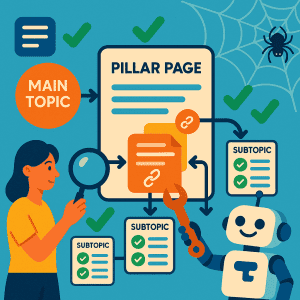A Smarter Way to Structure Your SEO
Search engines – and your readers – love well-organised content. That’s why content clusters (also called topic clusters) have become one of the best strategies for SEO.
This guide explains what content clusters are, how they help, and how you can build them using the content you already have (or plan to create).

🤔 What Is a Content Cluster?
A content cluster is a group of related pages built around a central topic. It usually looks like this:
- 🌟 Pillar Page – The main, comprehensive article on a core topic
- 🔗 Cluster Pages – Supporting articles that cover subtopics in more detail
- 🔁 Internal Links – Connect all pages together to guide both users and search engines
🧠 Why Content Clusters Work
- 📚 They help you cover a topic thoroughly
- 🔍 Google sees your site as an authority in your niche
- 🔗 Internal links pass value between pages
- 👤 They improve the user experience by guiding readers logically
🏗️ Example of a Simple Content Cluster
- 📄 “What is SEO?”
- 📄 “Can I Do SEO Myself?”
- 📄 “SEO Glossary”
- 📄 “How to use this site”
- 📄 “Free SEO Checklist”
Each supporting article links back to the main guide—and vice versa.
🛠️ How to Build a Content Cluster
- 🔎 Choose a main topic (something your audience cares about)
- 📑 Create a detailed, well-structured pillar page
- 📝 Write supporting pages focused on narrower subtopics
- 🔗 Add internal links between all the pages
- 🧭 Keep all content logically grouped in your navigation
🧰 Tools to Help You Plan Your Clusters
- 🟢 AnswerThePublic – Find subtopics people search for
- 🟡 Ubersuggest – Discover related keywords
- 🔵 MindMeister – Create visual topic maps
🚫 Common Mistakes to Avoid
- ❌ Creating lots of articles without a central pillar
- ❌ Forgetting to link cluster pages to each other
- ❌ Letting topics overlap too much—each page should have a clear purpose
✅ Quick Recap
- 🧱 Content clusters improve SEO by organising your site around themes
- 🪢 Pillar pages and cluster pages work together through internal links
- 🔍 This approach helps Google and users navigate your content more easily
🔗 Final Thoughts
Content clusters are your roadmap to topical authority. By creating a single, comprehensive pillar page and surrounding it with tightly focused cluster articles, you send a clear signal to search engines that you’re the go-to resource on that subject.
This structure not only improves crawlability and indexation, it guides readers through a logical journey—from broad overviews to in-depth answers – boosting engagement and dwell time.
To build your first cluster, start by choosing a pillar topic that aligns with your core offerings or audience questions. Use keyword research to uncover subtopics and long-tail variations, then craft individual articles for each of those angles.
Link every cluster piece back to the pillar page – and vice versa – using descriptive anchor text. This internal linking weaves depth and context into your site architecture, helping Google understand the relationship between pages and elevating the entire cluster’s visibility.
Maintaining clusters is just as important as creating them. Regularly review performance metrics in Search Console to identify underperforming pages, update content with fresh data or examples, and expand clusters as new questions emerge.
Avoid overlap by assigning each article a distinct focus and consolidating any that drift too close in scope. With a disciplined, well-linked cluster strategy, you’ll not only improve your rankings – you’ll deliver a cohesive, user-centred experience that keeps visitors exploring and converts curiosity into trust.
📝 Recap and Clarify: Page-Specific FAQs
What is a content cluster in SEO?
Why are content clusters important for SEO?
How do I create a content cluster?
What’s the difference between a pillar page and a blog post?
Do all topics need a content cluster?
How many cluster pages should I create?
Should cluster pages only link to the pillar page?
Can I use existing blog posts to build a content cluster?
Do content clusters work for local SEO?
How do I measure the success of a content cluster?
🔁 Up Next!
Evergreen vs Trending Content – Successful content strategies use a balance of two types of posts: evergreen and trending. Each has its strengths—and when used together, they can grow your traffic steadily while giving you bursts of visibility.
Also Read: How to Structure Topic Clusters That Actually Work for SEO
Video Recap – 🕸️ Content Clusters Explained — How to Build Topical Authority in 2025
Ever feel like your blog posts are competing with each other instead of helping you rank? In this video, I’ll show you how to build content clusters – the structure Google loves – to boost authority and dominate your niche.



